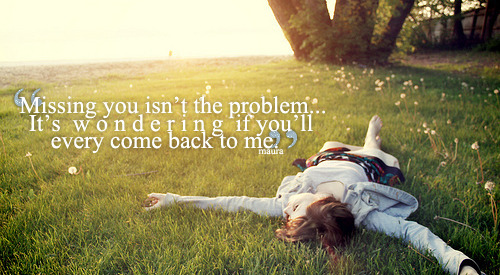Love Pictures With Quotes Definition
Source(Google.com.pk)
The love quote theory definition of love is quadripartic: four definitions can be
read as one sentence. I have alluded to three of these earlier. The fourth,
given below, will surely be the most controversial, but it can best be
understood in relation to the other three. Following, therefore, is the love
theory general definition of love:Part One -- Theologically, Love is God (and
vice versa).Part Two -- Metaphysically, love is a movement of the will toward
that which is perceived as good. 20Part Three -- Psychologically, love is
simultaneously the fundamental drive and goal of human life, the push and pull
of every human act, the raw force from which is derived and toward which is
aimed, all emotion, all thought, all volition (will), and all behavior.
Part Four -- Materially, physically, love is the fundamental "spiritual substance" from which the atom, the building block of all material reality, was created; as such, love remains in the atom as the elemental dynamic force, flux, medium, ether or energy that binds together and governs the functioning of every electron, proton, neutrino, quark and yet-to-be-found subatomic microparticle and of every movement of the macrocosmic physical universe. In short, love is reality.This quadruplex definition obviously moves love a quantum leap beyond the romance-, emotion-, biological and relationship-centered ways in which it has been typically defined. Yet, it refutes no one. Love is all the things that all the theorists, all the scientists, all the poets, all that thousands of other writers have said it is. It is just more -- far, far more.
So does this definition of love satisfy that task of describing the whole elephant, the entire empire, or on the contrary, does this four-dimensional definition, sweeping as it obviously is, still capture only a few facets of love, something less than the entire diamond? It has taken me forty years to write that definition.
During my many years of helping couples, both in pre-marital and marital counseling, there is one theory of “love” I’ve use over and over again to help everyone in the room learn to speak the same language about this ultimately important, yet incredibly confusing word. This theory, called the “Triangle Theory of Love,” was developed by Dr. Robert Sternberg, a Psychologist at Tufts University.
In a nutshell, the Triangular Theory of Love defines “love” as being composed of 3 qualities, passion, intimacy, and commitment. These 3 components can be defined as follows:The friendship or specialness of the relationship. The feelings of closeness, bondedness, connectedness, trust, and friendship in the relationship.The excitement or energy of the relationship. The feelings of physical attraction, romance, and arousal (particularly sexual arousal) in the relationship.The “business aspect” of the relationship. This includes all the shared investments, or the “history,” of the relationship, such as decisions, experiences, and adjustments.Passion tends to develop very quickly in relationships, followed by a gradual deterioration over time. Intimacy tends to increase somewhat quickly at first, then tapers off, growing more slowly for a time before finally leveling off. Commitment always starts at ground zero and increases over time for the duration of the relationship.As can be seen in the picture at the beginning of this article, these 3 components of love can be viewed as comprising the 3 sides of a triangle, with Commitment as the base, and Passion and Intimacy comprising the upper 2 sides. Depending on how much of each of these 3 components is present, a triangle can either be very small or very large. Also, although the picture of the triangle shown above depicts love as an equilateral triangle, it is seldom seen in this form.
Part Four -- Materially, physically, love is the fundamental "spiritual substance" from which the atom, the building block of all material reality, was created; as such, love remains in the atom as the elemental dynamic force, flux, medium, ether or energy that binds together and governs the functioning of every electron, proton, neutrino, quark and yet-to-be-found subatomic microparticle and of every movement of the macrocosmic physical universe. In short, love is reality.This quadruplex definition obviously moves love a quantum leap beyond the romance-, emotion-, biological and relationship-centered ways in which it has been typically defined. Yet, it refutes no one. Love is all the things that all the theorists, all the scientists, all the poets, all that thousands of other writers have said it is. It is just more -- far, far more.
So does this definition of love satisfy that task of describing the whole elephant, the entire empire, or on the contrary, does this four-dimensional definition, sweeping as it obviously is, still capture only a few facets of love, something less than the entire diamond? It has taken me forty years to write that definition.
During my many years of helping couples, both in pre-marital and marital counseling, there is one theory of “love” I’ve use over and over again to help everyone in the room learn to speak the same language about this ultimately important, yet incredibly confusing word. This theory, called the “Triangle Theory of Love,” was developed by Dr. Robert Sternberg, a Psychologist at Tufts University.
In a nutshell, the Triangular Theory of Love defines “love” as being composed of 3 qualities, passion, intimacy, and commitment. These 3 components can be defined as follows:The friendship or specialness of the relationship. The feelings of closeness, bondedness, connectedness, trust, and friendship in the relationship.The excitement or energy of the relationship. The feelings of physical attraction, romance, and arousal (particularly sexual arousal) in the relationship.The “business aspect” of the relationship. This includes all the shared investments, or the “history,” of the relationship, such as decisions, experiences, and adjustments.Passion tends to develop very quickly in relationships, followed by a gradual deterioration over time. Intimacy tends to increase somewhat quickly at first, then tapers off, growing more slowly for a time before finally leveling off. Commitment always starts at ground zero and increases over time for the duration of the relationship.As can be seen in the picture at the beginning of this article, these 3 components of love can be viewed as comprising the 3 sides of a triangle, with Commitment as the base, and Passion and Intimacy comprising the upper 2 sides. Depending on how much of each of these 3 components is present, a triangle can either be very small or very large. Also, although the picture of the triangle shown above depicts love as an equilateral triangle, it is seldom seen in this form.
Love Pictures With Quotes Animated For Myspace with quotes Tumblr For Her Him Facebook Download

Love Pictures With Quotes Animated For Myspace with quotes Tumblr For Her Him Facebook Download

Love Pictures With Quotes Animated For Myspace with quotes Tumblr For Her Him Facebook Download

Love Pictures With Quotes Animated For Myspace with quotes Tumblr For Her Him Facebook Download

Love Pictures With Quotes Animated For Myspace with quotes Tumblr For Her Him Facebook Download

Love Pictures With Quotes Animated For Myspace with quotes Tumblr For Her Him Facebook Download

Love Pictures With Quotes Animated For Myspace with quotes Tumblr For Her Him Facebook Download

Love Pictures With Quotes Animated For Myspace with quotes Tumblr For Her Him Facebook Download

Love Pictures With Quotes Animated For Myspace with quotes Tumblr For Her Him Facebook Download

Love Pictures With Quotes Animated For Myspace with quotes Tumblr For Her Him Facebook Download

No comments:
Post a Comment